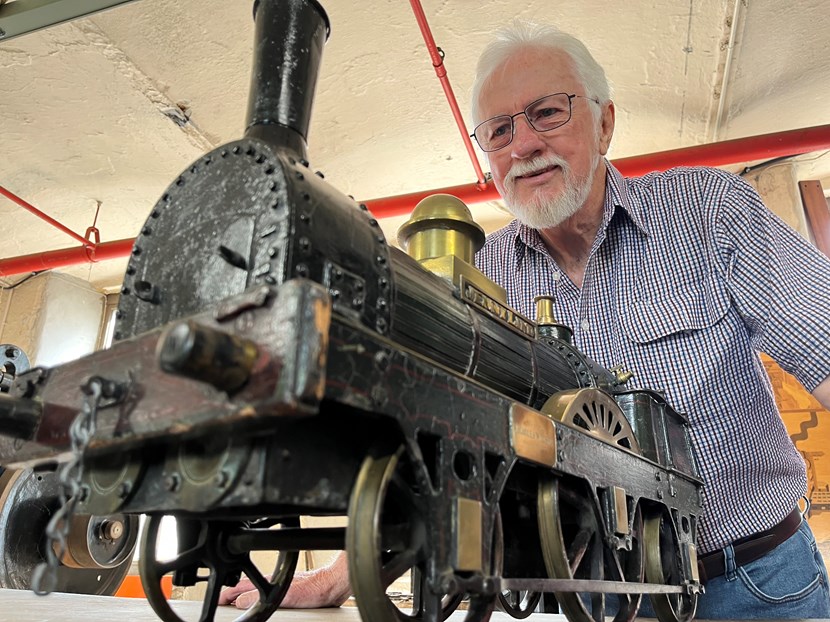
10 Jul 2023
Family reunion is a steam come true as Jenny Lind hits new high
A vintage, 160-year-old model steam locomotive named after a famed 19th century opera star had a fascinating family reunion with its maker’s Australian ancestor.
The detailed model of the Jenny Lind, crafted in Leeds in around 1849 by local train driver Charles Wilson, has been part of the collection of model locomotives at Leeds Industrial Museum since at least the 1970s.
Charles’s great grandson Rod Wilson recently made the 10,000 mile journey to Leeds from Caboolture, near Brisbane to see his ingenious forebear’s remarkable handiwork in person for the very first time.
Once a fully working miniature steam train, the model features a tiny coal-fired boiler, which still has remnants of the real coal inside which powered it decades ago.
The model is a replica of the full sized Jenny Lind, the first of a class of over seventy steam locomotives built from 1847 by E. B. Wilson and Company of Leeds.
Both the original and its miniature counterpart are named after Swedish soprano Jenny Lind, known as The Swedish Nightingale and hailed as one of the finest and most popular singers of her era.
Rod’s long trip followed a chance discovery online during some family history research, when he spotted a photo of the model in a blog written by industrial history curator John McGoldrick.
Rod realised the model closely matched another similar model in a photo handed down through generations of his family, which showed a smartly dressed Charles and his two sons riding it along a set of miniature tracks at the Bendigo Easter Fair in 1895.
After getting in touch with the museum, Rod and his wife Rayda were finally able to make the mammoth trip to Leeds and view the model in all its well-preserved glory.
Rod said: “It’s actually very emotional seeing it for the first time- this is a part of my family’s history. My aunt originally told me about Charles and showed me the photo of him and his sons, and it was only when I started researching his life that I realised what a fascinating person he was.
“There’s still a lot about Charles that we don’t know, but from the detail in the model and the craftsmanship that’s gone into it, it’s clear he was a very skilled and talented engineer.
“The fact he was able to pretty much step off the boat and make a new, successful life for himself and his family in Australia also says a lot about him too. It’s just amazing to see the model in person and to connect with him in this way after all these years.”
Records show that in 1849, Charles had been living with his young family in a small terraced house in Holbeck.
As well as driving trains for the Leeds and Thirsk Railway, he completed an engineering apprenticeship and was an enthusiastic model maker, recreating in astonishing detail the train he drove each day.
In fact his model was of such a high standard, it was selected to appear at the prestigious 1851 Great Exhibition of the Works of all Nations at the Crystal Palace.
Emigrating to Melbourne, Australia in 1852, Charles put his engineering skills to good use and immediately took charge of the Melbourne’s steam-powered waterworks.
By 1855, he was running a steamboat on the Yarra River before heading to the Victorian gold fields in around 1858 and building his first steam-powered quartz crushing mill.
As well as having gold mining leases he built a total of sixteen steam-powered quartz crushing mills which extracted gold for other mining leases as well as his own.
His success also allowed him to resume making models, with one exhibited in the Melbourne Exhibition of 1855 for which he was awarded a bronze medal. His models could even run on circular tracks and carry passengers.
After retiring he moved to Ballarat, the centre of gold mining in Victoria where he died in 1899.
John McGoldrick, curator of industrial history at Leeds Industrial Museum, said: “Models like the Jenny Lind are invaluable to our understanding of early locomotives and the important role Leeds played in the evolution of the railway industry.
“Getting this kind of unique background detail about the people whose time and ingenuity went into these remarkable models fills in some huge gaps in our knowledge and adds more depth and context to the collection. We’re hugely grateful to Rod for his help and it’s been wonderful to welcome him to the museum and to add a new chapter to the story of the Jenny Lind.”
Once the world’s largest woollen mill, Leeds Industrial Museum showcases an incredible array of vintage machinery including traditional looms and textile equipment.
Councillor Jonathan Pryor, Leeds City Council’s executive member of economy, culture and education, said: “The collection at Leeds Industrial Museum charts in incredible detail the journey Leeds has been on and the industries which have shaped the city we know today.
“The fact we are still finding new facets to that story demonstrates how rich and varied our local heritage is and how Leeds has influenced the lives of people around the world.”
For more information about Leeds Industrial Museum visit: https://museumsandgalleries.leeds.gov.uk/leeds-industrial-museum
ENDS
For media enquiries contact:
Leeds City Council Communications team
communicationsteam@leeds.gov.uk